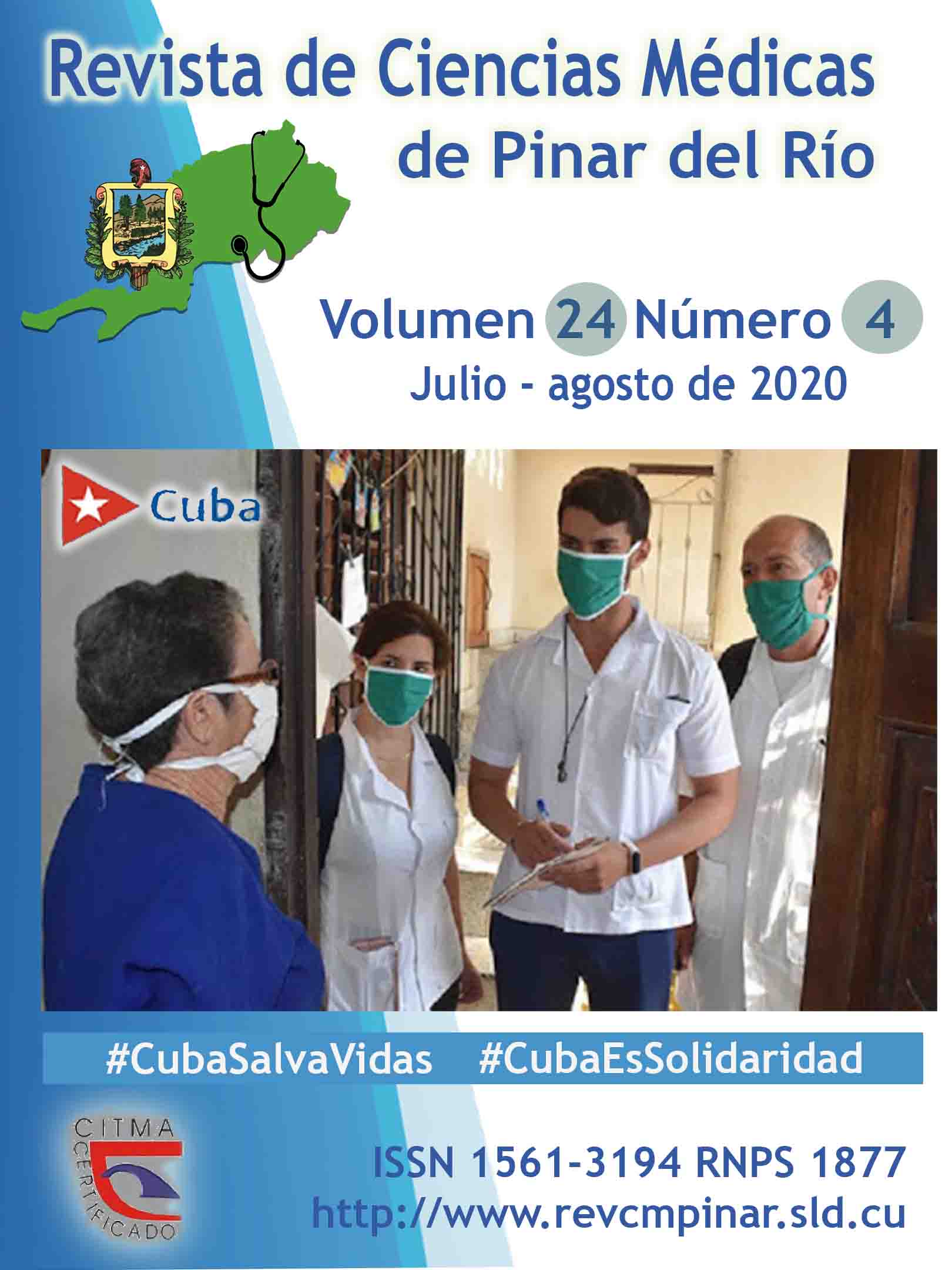Cerebrovascular disease in patients admitted to intensive care
Keywords:
CRITICAL CARE, CEREBROVASCULAR DISORDERS, RISK FACTORS, HYPERTENSION.Abstract
Introduction: cerebrovascular diseases are a global health problem and represent the third cause of death, the first cause of disability and the second cause of dementia.
Objective: to characterize clinical and epidemiologically cerebrovascular disease in patients admitted to intensive care.
Methods: observational, descriptive and cross-sectional study was conducted at Comandante Pinares General Hospital, Artemisa province, for the period of 2016-2018. A probabilistic and at simple random sample of 200 patients suffering from cerebrovascular disease was chosen. The study of the clinical histories allowed the collection of output information to the studied variables, using for its presentation methods of descriptive statistics. Medical ethics was respected.
Results: patients from 80 years and older predominated (26 %), male sex (56 %). Ischemic cerebrovascular strokes (83 %), thrombotic type (33 %) were frequent, where hypertension (93,5 %) and smoking (82 %) stated as the main risk factors, having the therapeutic window of 3-6 hours (73,5 %) as the most common, alive patients with sequelae at hospital discharged predominated (48,5 %).
Conclusions: patients older than 80 years and male, with hypertension and smoking addiction were prone to cerebrovascular stroke, where ischemic and thrombotic types were the most common, with a therapeutic window of three to six hours in the ajority of the cases. The greatest number of patients was admitted with obnubilation and they were discharged alive with sequelae.
Downloads
References
1. Ríos García M, Solís de la Paz D, Oviedo Bravo A, Ríos García M. Terapias artísticas en la rehabilitación de los pacientes tras un ictus. Rev Med Electrón [Internet]. 2018 [citado 25/09/2019]; 40(1): 25-34. Disponible en: http://scieloprueba.sld.cu/scielo.php?script=sci_arttext&pid=S1684-18242018000100004&lng=es
2. Hernández Oliva M, Padrón Mora M, Hernández Jiménez A, Núrquez Merlán A. Factores pronósticos de mortalidad en pacientes con enfermedad cerebrovascular en cuidados intensivos. Rev haban cienc méd [Internet]. 2018 [citado 25/09/2019]; 17(4): 567-578. Disponible en: http://scieloprueba.sld.cu/scielo.php?script=sci_arttext&pid=S1729-519X2018000400567&lng=es
3. Mendieta Pedroso MD, Bender del Busto JE, Pérez Pérez Y. Factores predictores de muerte en pacientes con infarto cerebral isquémico. Rev cubana med [Internet]. 2018 Sep [citado 25/09/2019]; 57(3): 16-24. Disponible en: http://scieloprueba.sld.cu/scielo.php?script=sci_arttext&pid=S0034-75232018000300003&lng=es
4. González Hernández A, Ferreiro Frontela D, Rodríguez Hernández N, Rodríguez Villalonga OL, Hernández Tamayo AJ. Caracterización de pacientes con hemorragia intraparenquimatosa espontánea. Univ Méd Pinareña [Internet]. 2019 [citado 25/09/2019]; 15(2): 205-213. Disponible en: http://revgaleno.sld.cu/index.php/ump/article/view/341
5. Ministerio de Salud Pública. Dirección de Registros Médicos y Estadística de salud. Anuario Estadístico de Salud 2018. [Internet]. 2019 Abril [citado 25/09/2019]. Disponible en: http://files.sld.cu/bvscuba/files/2019/04/Anuario-Electr%C3%B3nico-Espa%C3%B1ol-2018-ed-2019.pdf
6. Valhuerdi Cerero AJ, Llibre Guerra JJ, Valhuerdi PC, Porto Alvarez RB, Muñoz Rodríguez R, Muñoz Rodríguez M. Disfunción cerebral focal vascular en adultos mayores de la comunidad. Prevalencia, factores de riesgo aterogénico y manejo. Rev Med Electrón. [Internet]. 2015 [citado 25/09/2019]; 37(5): 452-468. Disponible en: http://scieloprueba.sld.cu/scielo.php?script=sci_arttext&pid=S1684-182420150005
Downloads
Published
How to Cite
Issue
Section
License
Authors who have publications with this journal agree to the following terms: Authors will retain their copyrights and grant the journal the right of first publication of their work, which will be publication of their work, which will be simultaneously subject to the Creative Commons Attribution License (CC-BY-NC 4.0) that allows third parties to share the work as long as its author and first publication in this journal are indicated.
Authors may adopt other non-exclusive license agreements for distribution of the published version of the work (e.g.: deposit it in an institutional telematic archive or publish it in a volume). Likewise, and according to the recommendations of the Medical Sciences Editorial (ECIMED), authors must declare in each article their contribution according to the CRediT taxonomy (contributor roles). This taxonomy includes 14 roles, which can be used to represent the tasks typically performed by contributors in scientific academic production. It should be consulted in monograph) whenever initial publication in this journal is indicated. Authors are allowed and encouraged to disseminate their work through the Internet (e.g., in institutional telematic archives or on their web page) before and during the submission process, which may produce interesting exchanges and increase citations of the published work. (See The effect of open access). https://casrai.org/credit/



